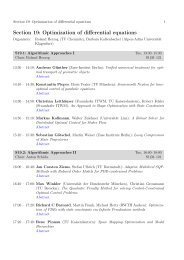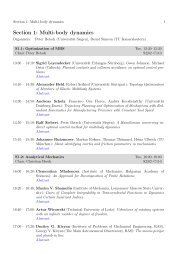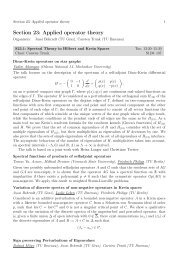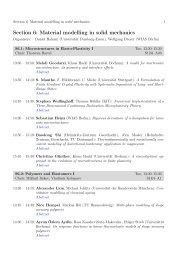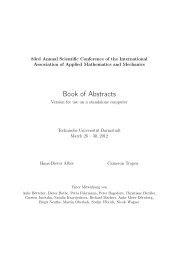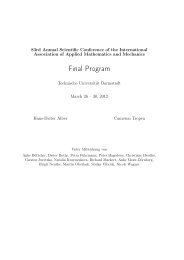Section 6: Material modelling in solid mechanics - GAMM 2012
Section 6: Material modelling in solid mechanics - GAMM 2012
Section 6: Material modelling in solid mechanics - GAMM 2012
You also want an ePaper? Increase the reach of your titles
YUMPU automatically turns print PDFs into web optimized ePapers that Google loves.
<strong>Section</strong> 6: <strong>Material</strong> <strong>modell<strong>in</strong>g</strong> <strong>in</strong> <strong>solid</strong> <strong>mechanics</strong> 23<br />
Application of an anisotropic growth and re<strong>modell<strong>in</strong>g</strong> formulation to computational<br />
topology optimisation<br />
Tobias Waffenschmidt (TU Dortmund), Andreas Menzel (TU Dortmund / Lund University)<br />
A classical topology optimisation problem consists of a problem-specific objective function which<br />
has to be m<strong>in</strong>imised <strong>in</strong> consideration of particular constra<strong>in</strong>ts with respect to design and state<br />
variables. In this contribution we present a conceptually different approach for the optimisation or<br />
rather improvement of the topology of a structure which is not based on a classical optimisation<br />
technique. Instead, we establish a constitutive micro-sphere-framework <strong>in</strong> comb<strong>in</strong>ation with an<br />
energy-driven anisotropic microstructural growth formulation, which was orig<strong>in</strong>ally proposed for<br />
the simulation of adaptation and re<strong>modell<strong>in</strong>g</strong> phenomena <strong>in</strong> hard biological tissues such as bones.<br />
The key aspect of this contribution is to <strong>in</strong>vestigate this anisotropic growth formulation with<br />
a special emphasis on its topology-optimis<strong>in</strong>g characteristics or rather topology-improv<strong>in</strong>g properties.<br />
To this end, several illustrative three-dimensional benchmark-type boundary value problems<br />
are discussed and compared qualitatively with the results obta<strong>in</strong>ed by classic topologyoptimisation<br />
strategies. The simulation results capture the densification effects and clearly identify<br />
the ma<strong>in</strong> load bear<strong>in</strong>g regions. It turns out, that even though mak<strong>in</strong>g use of this conceptually<br />
different growth formulation as compared to the procedures used <strong>in</strong> the more classic topologyoptimisation<br />
context, we identify qualitatively very similar topologies. Moreover, <strong>in</strong> contrast to<br />
common topology optimisation strategies, which mostly aim to optimise merely the structure,<br />
i.e. size, shape or topology, our formulation also conta<strong>in</strong>s the optimisation or improvement of the<br />
material itself, whichapart from the structural improvementresults <strong>in</strong> the generation of problemspecific<br />
local material anisotropy and textured evolution.<br />
Amplification damp<strong>in</strong>g properties of multiphase composites with spherical and fibers<br />
<strong>in</strong>clusions<br />
Sergey Lurie (Institute of Applied Mechanics, RAS), Natalia Tuchkova (Dorodnicyn Comput<strong>in</strong>g<br />
Centre, RAS), Juri Soliaev (Institute of Applied Mechanics, RAS)<br />
We consider composite materials re<strong>in</strong>forced with spherical and fibrous <strong>in</strong>clusions coated with a<br />
layer of lossy viscoelastic material. For the coat<strong>in</strong>g layers, typical viscoelastic properties of a polymer<br />
at and well above the glass transition region are assumed. It is shown that the remarkable loss<br />
amplification mechanism is also operative <strong>in</strong> such particulate-morphology materials. The aim of<br />
our study is to determ<strong>in</strong>e the effective loss modulus composites, which formally def<strong>in</strong>es the rate<br />
of energy dissipation per unit volume. We use a comb<strong>in</strong>ation of model<strong>in</strong>g and numerical tools<br />
to study composite materials consist<strong>in</strong>g of a matrix filled with spherical and fibrous <strong>in</strong>clusions<br />
coated with a layer of lossy viscoelastic material.<br />
The method of the four phases is used to describe the damp<strong>in</strong>g properties of composites<br />
filled with multiphase spherical <strong>in</strong>clusions and monolayer with multiphase fibrous <strong>in</strong>clusions. The<br />
constituent phases are supposed to be isotropic. Us<strong>in</strong>g the Eshelby method the effective moduli<br />
are determ<strong>in</strong>ed self-consistently, by requir<strong>in</strong>g that the average stra<strong>in</strong> <strong>in</strong> the composite <strong>in</strong>clusion<br />
is the same as the macroscopic stra<strong>in</strong> imposed at <strong>in</strong>f<strong>in</strong>ity. The analytical solution of this problem<br />
were received. The effective dynamic modulus and loss modulus were found us<strong>in</strong>g a viscoelastic<br />
analogy.<br />
It is shown[1] that the analytical give very similar, practically <strong>in</strong>dist<strong>in</strong>guishable predictions<br />
from the numerical solutions which were received us<strong>in</strong>g f<strong>in</strong>ite element method. Hence, when<br />
study<strong>in</strong>g such systems one can rely on the predictions of the four-phase sphere model, which<br />
are much easier to achieve than the f<strong>in</strong>ite element ones. a polymer at and well above the glass<br />
transition region are assumed. It is shown that by optimiz<strong>in</strong>g the thickness of the layers, one can<br />
achieve multiphase materials with effective loss characteristics significantly exceed<strong>in</strong>g those of the



